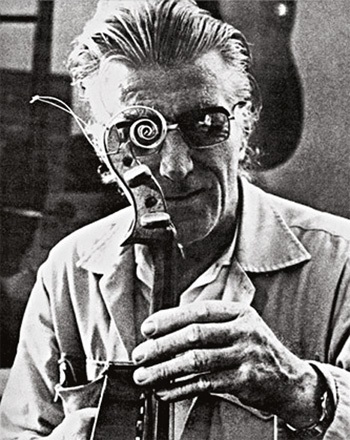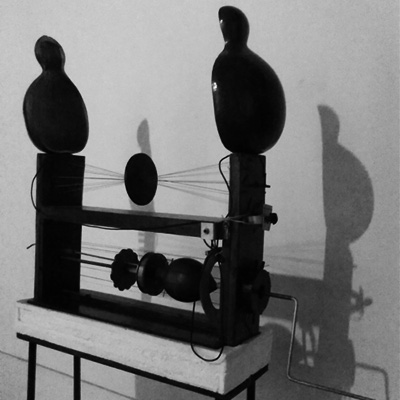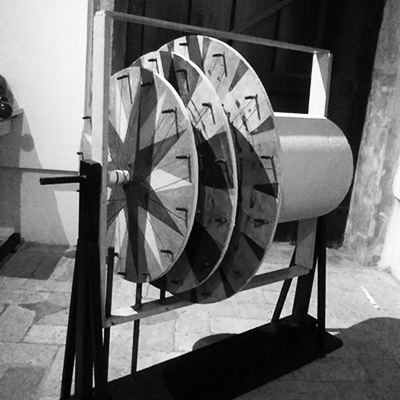
Liza Lim on Smetak & The Spinning World
Liza Lim writes music marked by visceral energy and vibrant colour and often explores ritual forms and performance aesthetics from Asian and Australian Aboriginal cultural sources. She is a vanguard of contemporary classical music composition.
Liza reflects on her time in Brazil and the influence of Swiss-born composer and artisan Walter Smetak on her work Ronda - The Spinning World.

I was very fortunate to visit Salvador da Bahia, Brazil for a two week residency in July 2016 at the invitation of the Goethe Institut there, in association with the DAAD Artists-in-Berlin programme and Ensemble Modern, as part of a project re-imagining aspects of the work of Walter Smetak (1913-1984), visionary composer, ‘cellist, philosopher and instrument builder.
In Salvador I spent time at the Museum Solar Ferrão that houses the 150-plus instruments invented and built by Smetak, as well as meeting musicians associated with Smetak and members of his family.

The axes of evolution.
Walter Smetak conceptualised the world as polarities of energy flowing across and spiralling around axes of evolution and he built his instruments or Plásticas Sonoras (sound sculptures) to express his complex symbology of spiritual relations. At the museum, I was immediately drawn to several of his rotating kinetic instruments: the impressive Máquina do Silêncio or Machine of Silence; the Três Sóis and particularly to the Ronda which Smetak called ‘a carrousel producing sounds’.

Rather like Stockhausen’s insight into the unity of pitch and rhythm as a function of time, Smetak says, ‘It is the slow turn that sets the rhythm. It creates intervals. At a faster speed, the instrument does not allow us to perceive the intervals, forming a melodic line. At an even faster speed, we only hear harmonies, because the rotation is so fast that we hear many strings at the same time. We thus can conclude that rhythm, melody and harmony depend on the speed of rotation. They are three elements in one that depend on speed.’

The harmony of circles within circles expressed in Smetak’s instruments was something that I connected to a wider idea of a Brazilian poetics of sound and movement. In Salvador da Bahia I became attuned to the city’s dense sonic fabric of drumming, singing and high-keyed voices. One of the most memorable audio experiences I had was in a careening taxi with its radio blaring out a virtuosic barrage of vocal articulation – a mash-up of sports commentary, evangelical outpouring and advertising spiel punctuated with abrupt fragments of cheesy electronica. The composer Daniel Moreira commented that ‘life in Salvador has a continuous soundtrack’ and the nature of this soundtrack perhaps expresses some essence of a Brazilian poetics of sound.
Sound is experienced as multi-dimensional, spatially dynamic phenomena.
It is not frontal or presentational in its acoustics but highly immersive, circulating and generative in its relations and here I recall the ethnomusicologist Jason Stanyek’s evocative descriptions of capoeira, the Afro-Brazilian dance-like martial arts form as an inside-out, upside-down spinning world that is an ultimate expression of brasilidade (Brazilianness). Capoeira is played within a roda – the living circle of the group, within which participants spin and wheel in stylized combat. Stanyek says the roda is ‘typically conceptualized by capoeiristas as being a kind of world in miniature’, and quotes Danielle Goldman: ‘the world making potential of improvisation involves the ability to make new spaces, to create and form one’s surroundings continually, as one would wish them to be’.3 Another striking example of the world-making circle in Brazilian culture can be found in Candomblé rituals where the danced and sung circle is the powerful dynamo for opening portals of communication between the human and spirit worlds.
'Time does not go by, time grows.’
The experience of life in circulation and the arcs of its relational forces that are so amplified in Smetak’s work and in the daily round of Salvador da Bahia find some corresponding expressions in my composition. It is found in the instruments and their spatialisation in a bow-formation of stringed instruments that carry tensile force to a perpendicular plane mapped out by percussion and a solo trumpet. It is found in the mobile sound sources of itinerant brass instruments playing wonderfully home-made Piston Cretinowhose funnel-mouth is placed on the belly of the musicians to produce a kind of extravagant invented language. It is found in the music’s irregular repetitions nested inside each other and in a form made out of a profusion of gestures so that, as Smetak says: 'Time does not go by, time grows'.
Words by Liza Lim
Hear Liza Lim's work 'Rondo - The Spinning World' when acclaimed ensemble ELISION performs it live during Metropolis Festival on 18 April 2018
Endnotes:
- Karlheinz Stockhausen, ‘…how time passes…’, (English trans. Cornelius Cardew), Die Reihe (‘Musical Craftsmanship’), Vol 3, 1959.
- Walter Smetak, Simbologia Dos Instrumentos, Associação dos Amigos de Smetak, 2001. Symbology of Instruments, (unpublished English transl.), p.38. For an overview of the instruments, see: Tuzé de Abreu, ‘Smetak and his instruments’ ‘Smetak and his instruments’, trans. Denice Maria Figueiredo Santos Music review – Federal University of Bahia, ART 025, SEP 2013.
- Jason Stanyek, ‘“A Thread that Connects the Worlds”: Ovoid Logics and the Contradictory Lines of Force of Brazilian Improvisations’. Critical Studies in Improvisation / Études critiques en improvisation, Vol 7, No 1, 2011, p.2.
- Smetak, p.30.

